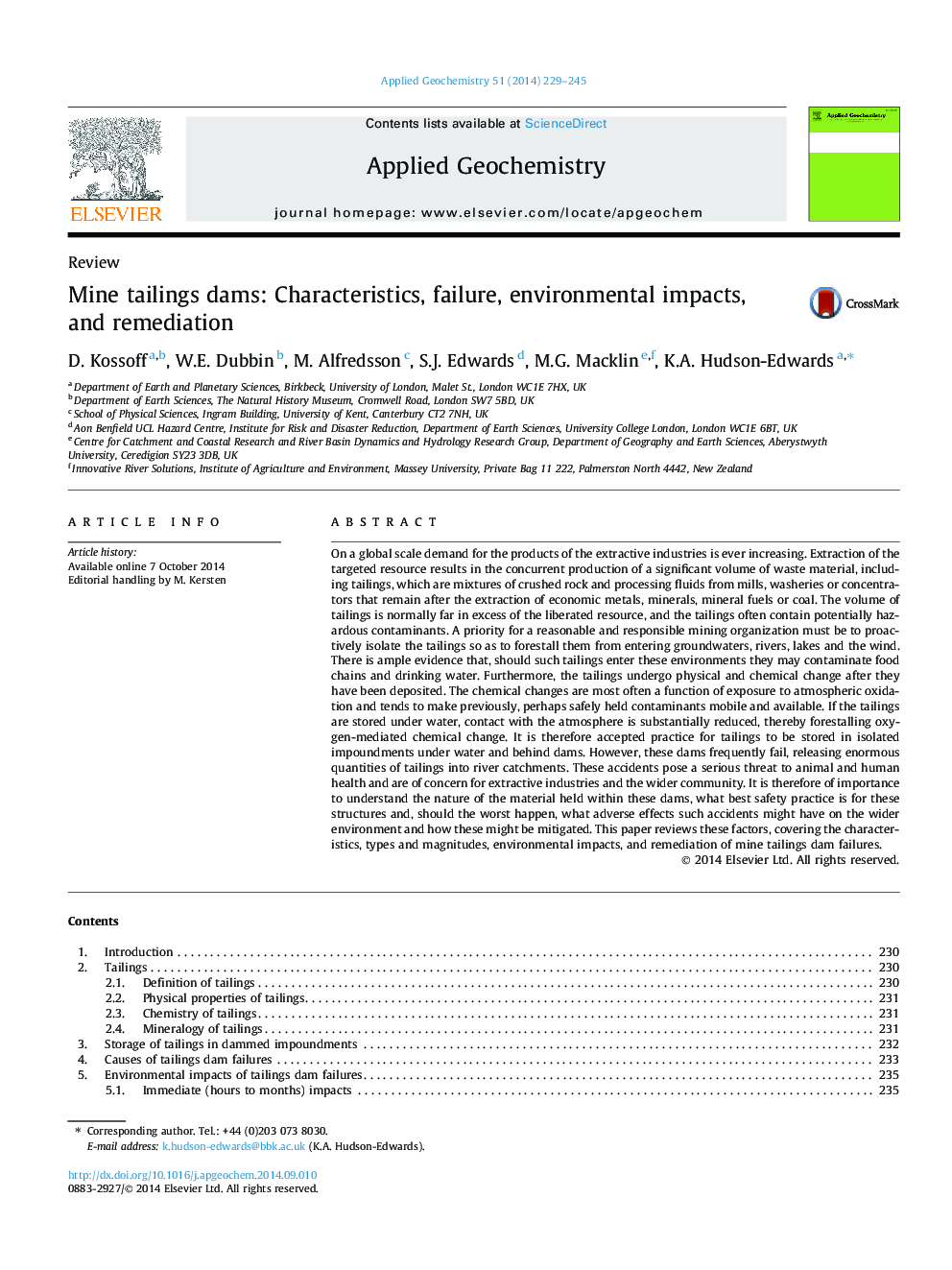| کد مقاله | کد نشریه | سال انتشار | مقاله انگلیسی | نسخه تمام متن |
|---|---|---|---|---|
| 6335083 | 1620240 | 2014 | 17 صفحه PDF | دانلود رایگان |
عنوان انگلیسی مقاله ISI
Mine tailings dams: Characteristics, failure, environmental impacts, and remediation
ترجمه فارسی عنوان
سدهای سیل ماین: مشخصات، شکست، اثرات زیست محیطی، و اصلاح
دانلود مقاله + سفارش ترجمه
دانلود مقاله ISI انگلیسی
رایگان برای ایرانیان
ترجمه چکیده
در مقیاس جهانی تقاضا برای محصولات صنایع استخراجی همچنان در حال افزایش است. استخراج منابع مورد نظر منجر به تولید همزمان حجم قابل توجهی از مواد زائد، از جمله بتونه ها می شود که مخلوط سنگ خرد شده و مایعات پردازش شده از کارخانه ها، واشرها یا کنسانتره هایی است که پس از استخراج فلزات، مواد معدنی، سوخت های معدنی یا زغال سنگ حجم بتونه ها معمولا بیش از منابع آزاد شده است و بذرها اغلب دارای آلاینده های بالقوه خطرناک هستند. یک اولویت برای سازمان معقول و مسئول معدن باید بتدریج بتدریج را از بین ببرد تا بتواند از ورود به آبهای زیرزمینی، رودخانه ها، دریاچه ها و باد جلوگیری کند. شواهد فراوانی وجود دارد که اگر چنین بیماری هایی وارد این محیط شوند، ممکن است زنجیره های غذایی و آب آشامیدنی را آلوده کنند. علاوه بر این، پساب ها پس از سپرده شدن، تغییرات فیزیکی و شیمیایی را تحمل می کنند. تغییرات شیمیایی اغلب از نظر قرار گرفتن در معرض اکسیداسیون جو است و تمایل دارد که قبلا ایجاد شود، شاید آلوده کننده های تلفن همراه و در دسترس باشند. اگر بتونه ها در زیر آب ذخیره شوند، تماس با جو به طور قابل ملاحظه ای کاهش می یابد، بنابراین پیشگیری از تغییر شیمیایی توسط اکسیژن است. به همین دلیل است که ضایعاتی که در آبهای زیرزمینی و در پشت سدها ذخیره می شوند، قابل قبول است. با این حال، این سدها اغلب شکست می خورند، مقدار زیادی از سیلاب ها را به حوضه های رودخانه آزاد می کنند. این حوادث یک تهدید جدی برای سلامت حیوانات و انسان ها است و نگران صنایع استخراجی و جامعه گسترده هستند. از این رو اهمیت دارد که ماهیت مواد درون این سدها را درک کنید، بهترین روش ایمنی برای این سازه ها، و اگر بدترین اتفاق بیافتد، چه اثرات نامطلوب چنین حوادثی ممکن است بر محیط زیست گسترده تر و چگونگی کاهش این موارد داشته باشد. این مقاله این عوامل را بررسی می کند، شامل ویژگی ها، انواع و بزرگی، اثرات زیست محیطی و اصلاح آسیب های سد معدنی می شود.
موضوعات مرتبط
مهندسی و علوم پایه
علوم زمین و سیارات
ژئوشیمی و پترولوژی
چکیده انگلیسی
On a global scale demand for the products of the extractive industries is ever increasing. Extraction of the targeted resource results in the concurrent production of a significant volume of waste material, including tailings, which are mixtures of crushed rock and processing fluids from mills, washeries or concentrators that remain after the extraction of economic metals, minerals, mineral fuels or coal. The volume of tailings is normally far in excess of the liberated resource, and the tailings often contain potentially hazardous contaminants. A priority for a reasonable and responsible mining organization must be to proactively isolate the tailings so as to forestall them from entering groundwaters, rivers, lakes and the wind. There is ample evidence that, should such tailings enter these environments they may contaminate food chains and drinking water. Furthermore, the tailings undergo physical and chemical change after they have been deposited. The chemical changes are most often a function of exposure to atmospheric oxidation and tends to make previously, perhaps safely held contaminants mobile and available. If the tailings are stored under water, contact with the atmosphere is substantially reduced, thereby forestalling oxygen-mediated chemical change. It is therefore accepted practice for tailings to be stored in isolated impoundments under water and behind dams. However, these dams frequently fail, releasing enormous quantities of tailings into river catchments. These accidents pose a serious threat to animal and human health and are of concern for extractive industries and the wider community. It is therefore of importance to understand the nature of the material held within these dams, what best safety practice is for these structures and, should the worst happen, what adverse effects such accidents might have on the wider environment and how these might be mitigated. This paper reviews these factors, covering the characteristics, types and magnitudes, environmental impacts, and remediation of mine tailings dam failures.
ناشر
Database: Elsevier - ScienceDirect (ساینس دایرکت)
Journal: Applied Geochemistry - Volume 51, December 2014, Pages 229-245
Journal: Applied Geochemistry - Volume 51, December 2014, Pages 229-245
نویسندگان
D. Kossoff, W.E. Dubbin, M. Alfredsson, S.J. Edwards, M.G. Macklin, K.A. Hudson-Edwards,
